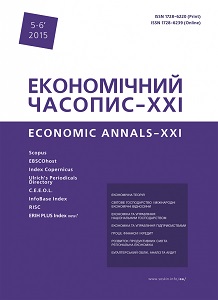Стратегічний вибір банку на різних стадіях його життєвого циклу
Commercial bank’s strategic choice on the different life cycle stages
Author(s): Iryna ChmutovaSubject(s): Economy
Published by: Institute of Society Transformation
Keywords: Bank; Corporate Strategy; Strategic Goals; Life Cycle
Summary/Abstract: The purpose of the paper is to improve the technology of a commercial bank’s corporate strategy choice taking into account the cyclicity of its development. Methods. The methods of theoretical generalisation, analysis and synthesis were applied to prove compliance of bank’s corporate strategy with life cycle stage. Banks’ life cycle stages were identified based on cluster analysis. Results. A list of strategies that most closely correspond to the bank’s life cycle stages has been made. It includes the creation stage related to the strategy of concentrated growth; the extensive growth stage related to the strategy of expansive growth; the intensive growth stage related to the strategy of diversified growth; the maturity stage related to the strategy of diversified growth (if a bank intends to return to the growth stage) or stabilization (if the priority is to maintain the existing position); the decline stage related to the strategy of reorientation or «cutting off the excess» if restoration of the viability is desired, and the «harvesting» strategy or liquidation if closing of the business is required. The stages of the Ukrainian banks’ life cycle were defined on the basis of different indicators, such as market share annual growth, income annual growth, personnel expenses annual growth, through banks grouping with the use of cluster analysis. The relevance of strategies applied by the banks in Ukraine to stages of their life cycle has been analyzed, and recommendations concerning their strategic choices have been provided. Conclusions. Supplying banks with tools to enhance the validity of corporate strategy formation which is considered to be the most appropriate to the current stage of their development and will minimize the risk of strategic gaps. It will also help to escape the downward spiral of development, create opportunities for stabilizing the current life cycle stage and restore viability.
Journal: Економічний часопис - ХХІ
- Issue Year: 151/2015
- Issue No: 05+06
- Page Range: 94-97
- Page Count: 4

